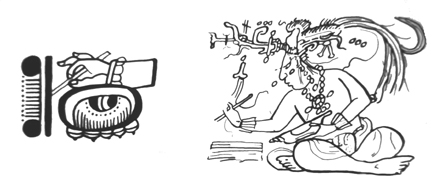The Mayan writing system, like their calendar, was the most advanced in Mesoamerica. Almost 800 glyphs have been identified by Michael Coe and his team, a number equivalent to the number used in Egyptian hieroglyphics. What made the Mayan written language difficult to translate is that it is a system based on both LOGOGRAPHS (symbols representing whole words or concepts) and symbols representing syllables or sounds in the Mayan language. It is the only true writing system developed in Pre-Columbian America. In this example, we see on the right an illustration of an artist/scribe taken from a Mayan ceramic vessel. He paints on a codex with a brush. The brushes used were very similar to Japanese calligraphy brushes: a hollow tube tipped with hair from dogs, goats, or humans. The scribe wears the usual kilt, jade jewelry, and elaborate quetzal feather headdress, and sits cross legged. In his left hand, he holds a conch shell paint pot. In burials, archaeologists have found these shell paint pots, still holding pigments, showing these were valued possessions of the artist/scribe. Pigments used included the typical earth minerals, such as iron oxide. Note the extremely sloping forehead of the artist/scribe. The ruling Maya elite did use the practice of binding the heads of newborn babies to shape their crania into a form which was considered more beautiful.
At left is the logograph, ah-ts'ib, which literally means, 'he, the artist,' and here it is easy to see the writing hand, painted so similarly to that in the full illustration of the artist at right.

Illustration of an artist/scribe taken from a Mayan ceramic vessel (Right) and
the Mayan logograph ah-ts'ib, meaning 'he, the artist' (Left)
Classic period


